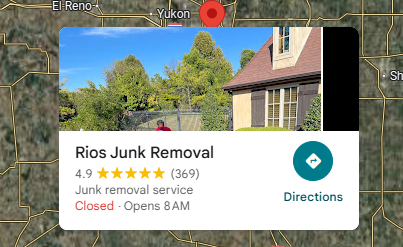Junk Removal Impact on Reducing Waste in Residential Areas
Clutter in warehouses not only hampers aesthetics but also impacts safety, productivity, and employee morale.
Norman, OK, United States, 16th Oct 2025 – Nestled quietly behind every operational warehouse lies a fundamental yet often overlooked truth: clutter tends to multiply. Items accumulate, corners fill with forgotten tools, and pathways narrow under the weight of unused materials. Yet, the consequences of letting these piles grow unchecked stretch far beyond mere aesthetic decay. In fact, the regular cleansing of warehouse space is a strategic necessity—one that touches safety, productivity, environmental impact, operational clarity, and even employee morale.
The Invisible Toll of Accumulated Clutter
When clutter gradually takes over, its effects may sneak in unnoticed at first. A narrow aisle, a misplaced pallet, or a dormant piece of equipment tucked under dust suddenly becomes a hazard—not only for accidents but also for the smooth flow of daily operations. Workers, weaving around obstacles, lose precious time and inadvertently increase the risk of trips, strains, or collisions. And then there’s the psychological burden: a chaotic environment can leave even the most seasoned employee feeling off-kilter, frustrated, or low on confidence.
Over time, inefficiencies mount. Searching for tools, materials, or documentation morphs into an unintended scavenger hunt. Preparation for inventory audits or safety inspections turns frantic, as hidden hazards or hard-to-find items throw last-minute curveballs into the process. As it turns out, what seems like an effortless oversight—a small pile here, an unfilled shelf there—can snowball into a series of disruptions that ripple outward.
A Well-Timed Cleanout as a Strategic Reset
Contrast that scenario with the surge of clarity that comes from a thorough warehouse cleanout. On a single day, stacks of obsolescent materials vanish, pathways clear, and open zones emerge—inviting both movement and purpose. Equipment becomes accessible, storage systems breathe once more, and inventory workflows find their rhythm. This isn’t just an erasure of mess; it’s the reestablishment of operational intention.
A thoughtful sweep through the facility invites a measure of serenity. Clean floors reflect structured aisles, and freshly organized racks suggest forward motion. In that recalibrated space, employees gain renewed focus, supervisors rediscover oversight ease, and the warehouse almost hums with unapologetic efficiency. Without that choreographed cleanup, the warehouse can slowly drift toward disarray, suffocating good routines under indiscernible piles.

Safety First: More Than Just a Motto
Safety isn’t a slogan; it’s a living, breathing priority. When clutter hides electrical cords, blocks exits, or creeps into loading zones, it transforms benign spaces into hazardous ones. The stakes grow higher in warehouses where forklifts navigate tight quarters or where stock moves constantly. Each compromised route represents a potential accident—not merely a mishap, but a serious disruption that could ripple into downtime, injury, and liability.
Imagine the difference between a clutter-filled aisle and one where emergency exits are accessible, floors are clear, and zones for pedestrian traffic are unambiguous. One scene invites danger; the other invites calm. Regular cleanouts, then, become a form of preventive care—barriers to injury, to mishaps, to unnecessary financial cost. Clear space, clearly marked zones, safe pathways: these are the foundations of a responsible operation.
Operational Agility Through Streamlined Spaces
Operational agility—the ability to pivot, adapt, and deliver—is rooted in physical space as much as in teamwork or digital systems. When clutter fades, space becomes versatile. New shelving structures can be installed without uprooting chaos, bulk shipments can be staged with intention, and seasonal transitions (whether ramping up for holiday demand or scaling down for inventory audits) proceed with grace rather than clamor.
The benefit compounds: fewer delays in locating items, faster loading and unloading, a diminished need for temporary storage solutions, and minimized risk of damage to goods. Clean floors and open zones transform the warehouse from a static storeroom into a dynamic workspace that responds fluidly to shifting demands.
Environmental Responsibility Without Compromise
A warehouse cleanout needn’t simply relegate castoff items to landfill rows. There lies an opportunity for conscientious action: salvage what’s reusable, donate where possible, recycle what can be turned into new resources. The company behind the inspiration for this piece places emphasis on donation and recycling as cornerstones of its removal services.
By integrating similar eco-aware principles into warehouse cleanouts, one can mitigate environmental impact. Imagine directing functional pallets to local charities, redirecting office furniture to community centers, recycling cardboard and plastics—all while decluttering the workspace. This eco-friendly ethos aligns operational cleanup with broader social responsibility, positioning the warehouse as more than just a storage space—it becomes a conduit for mindful stewardship.
Boosting Morale, Culture, and Confidence
There’s something deeply motivating about a clean, organized space. The simple act of clearing clutter fosters emotional clarity, which can have a profound impact on morale and productivity. Employees who arrive at a tidy, well-maintained warehouse feel valued and empowered, knowing that their environment is cared for and conducive to efficient work. In contrast, cluttered spaces signal disorder, causing feelings of stress and reduced confidence. It sends the message that things are out of control, and this can trickle down into the quality of work produced.
A well-kept environment exudes order, control, and respect—creating a culture where employees can focus on the task at hand with a clear mind. Involving the team in the cleanout process—whether through scheduled clearing days, team-building activities, or incentivized programs—reinforces the idea that their input and environment matter. This collective effort fosters a sense of pride in the workspace, strengthens team identity, and contributes to a culture that prioritizes safety and quality at every level.
Long-Term Cost Savings Through Smart Cleanouts
While it might seem counterintuitive, regularly scheduled warehouse cleanouts can save money over time. The immediate benefit is improved efficiency, as it becomes easier and faster to retrieve items when the warehouse is organized. With less clutter around, there’s a lower risk of damaging goods, equipment, or tools, which often happens when things are misplaced or knocked over. Clean environments also contribute to the longevity of equipment, as there’s less chance of accidental impacts that could cause wear and tear.
Additionally, clear inspection routes ensure that regulatory compliance checks are smoother, reducing the risk of penalties or delays. Some companies even discover that after cleaning up, they can downsize storage rentals or optimize existing space to avoid the need for expansion. This not only cuts costs but also eliminates the need for costly capital investments. By viewing cleanouts as strategic investments, organizations can create long-term financial benefits that far outweigh the initial effort required to declutter.
Planning Smarter, Not Sweating Harder
Regular warehouse cleanouts are far from casual undertakings—they require thoughtful planning, efficient allocation of resources, and diligent follow-up. However, the benefits that stem from this investment are significant. The process shouldn’t be rushed or left to chance; it’s a strategy that pays off with long-term advantages. For instance, scheduling quarterly cleanouts, ideally during slower business periods or fiscal checkpoints, can turn traditionally quiet times into opportunities for physical and organizational reset.
These periods of calm provide the perfect window to focus on decluttering, repairing, and realigning the warehouse’s layout. In addition to quarterly efforts, smaller, more frequent micro-cleanouts, such as team-driven tidying of specific zones, can supplement larger cleanout sessions. Documentation of each session—recording what was removed, where it went, and any improvements made—can provide valuable insights into future cleanout strategies. Over time, the cleanout process becomes a natural part of operations, fostering a culture of cleanliness, organization, and continuous improvement without feeling burdensome.
Embracing a Cleanout Mindset in Daily Operations
One-off cleanouts are valuable, but cultivating an ongoing mindset of tidiness is where the true benefits lie. The key to sustaining a clean warehouse is embedding these habits into daily operations. Encouraging employees to tidy up as they go—whether it’s properly storing tools after use, putting away items immediately, or discarding trash promptly—keeps clutter from building up. It’s about creating a routine where employees are constantly aware of their space and can maintain organization without the need for a major effort.
Simple actions like ensuring things are in their designated zones, labeling shelves, and managing inventory regularly ensure that clutter doesn’t become a problem again. What begins as an intensive, periodic cleanout effort evolves into a rhythm of continual order, where chaos is avoided before it takes root. This culture of tidiness nurtures smoother workflows, improved safety, and purposeful movement, making the warehouse a dynamic environment that’s always prepared for whatever demands arise
Converging Benefits: The Full Circle
Regular warehouse cleanouts weave an elegant loop of benefits: safety begets efficiency; efficiency begets cost savings; cost savings embolden investments in sustainability; sustainability reinforces pride and morale; and morale feeds back into disciplined upkeep. That circle transforms a warehouse from a static silo of accumulation into a living, breathing operation—rooted in safety, optimized for flow, and animated by clarity.
When the warehouse shines, so do the people who operate within it. Workers move with assuredness. Supervisors oversee with confidence. Leadership invests with knowledge. And the organization gains agility not from rapid fixes, but from steady, deliberate maintenance of space and spirit.
Conclusion
A warehouse is far more than just a storage facility—it’s a space that mirrors an organization’s values, precision, and commitment to excellence. Regular warehouse cleanouts go beyond mere tidying up; they are intentional efforts to bring clarity, safety, and fresh opportunities. When handled strategically, these cleanouts enhance operational efficiency, reduce potential risks, promote environmental responsibility, and help cultivate a positive workplace culture rooted in respect and pride.
For those seeking professional assistance in reclaiming and optimizing their operational space, Rios Junk Removal is here to help. Based in Oklahoma City, Rios Junk Removal offers comprehensive junk removal and cleanout services, with a commitment to eco-friendly practices. Contact them at 405-397-4751 to schedule a cleanout that will transform your workspace.
Rios Junk Removal LLC
2990 72nd ave NE
4053974751
Company Details
Organization: Rios Junk Removal LLC
Contact Person: Rios Junk Removal LLC
Website: https://riosjunk.com/
Email: Send Email
Contact Number: +14053974751
Address: 2990 72nd ave NE
City: Norman
State: OK
Country: United States
Release Id: 16102535509

